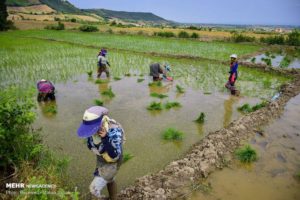July 19, 2019

The regime has decided to ban rice cultivation in all but the two wettest provinces adjoining the Caspian Sea because of the country’s severe water shortage.
The ban will not take effect for three years to give farmers time to shift to new crops, but after that rice will only be grown in Gilan and Mazandaran.
According to Deputy Agriculture Minister Alimorad Akbari, the decision has already been made by the cabinet and conveyed to all 31 provinces.
“Rice cultivation will first be restricted for three years, as farmers will receive no support from the government in provinces other than Gilan and Mazandaran during this period,” Akbari was also quoted as saying by Mehr News Agency.
After the three years, there will be an all-out ban on rice cultivation, except for in Gilan and Mazandaran.
“We are facing climate change in Iran and therefore, need to adopt a long-term vision to devise cultivation patterns,” he said.
Agricultural and environmental experts have been urging the government for years to limit rice farming to the water-rich provinces of Gilan and Mazandaran, which are home to a majority of Iran’s paddy fields.
Apart from the two northern provinces, rice is currently cultivated in Khuzestan, Esfahan, Fars, Kohgilouyeh va Boyer Ahmad, Chaharmahal va Bakhtiari, Ilam, Qazvin, Lorestan, Zanjan, Sistan va Baluchestan, Kurdestan, Ardabil, East Azarbaijan and Khorasan North provinces, the Financial Tribune said.
The water crisis in Iran has become so severe that agricultural officials have expressed concerns regarding rice farming even in the north where precipitation levels are higher.
The Director of the Iran Water Industry Federation, Abdol-Reza Foroughi, recently said, “The revenue earned from the sale and export of many types of crops does not equal the value of water used for their irrigation.”
More than 90 percent of Iran’s water resources are used by agriculture. In most countries, the vast majority of water supplies are devoted to farming.
Iranians consume 3.2 million tons of rice per annum while domestic production stands at 2.2 million tons. Iran is mainly importing rice from the UAE, India, Pakistan, Thailand, Turkey and Iraq.